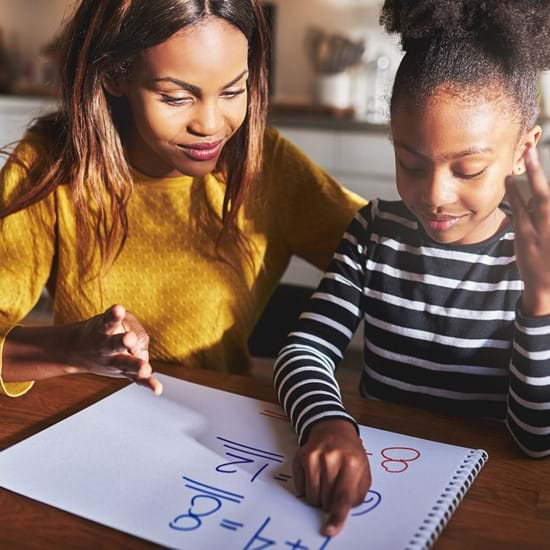
Homework: 9 Quick Tips to Boost Your Child’s Concentration

Written by: Nanny Secours
Balance
Adopting healthy habits is a key element that contributes to a child’s school success. A good night’s sleep will increase their attention span and focus both at school and at home.
Children who do their homework right after school will focus better if they have a snack and a glass of water first. If they do their homework after dinner, they should eat a meal that is substantial but not too heavy, otherwise their energy level will drop.
To release the day’s stress, it’s important to have some downtime and take a break when your child comes home from school. Suggest a motor activity and avoid screen time. This break offers an opportunity to spend some quality time with your child and talk about how the day went. Your child will have the right mind set for homework after and be more inclined to stay on task.
Tip 1: Peace and Quiet
Create a favourable environment by limiting distractions (radio, TV, cell phones, video games, etc.), with special emphasis on video games, as these are often a challenge for families with several children. Since kids sometimes have to wait for their turn to get help from a parent, turning to video games while waiting becomes tempting. The child who is trying to concentrate is then distracted by the desire to play too, or by the shouts of his siblings, the game score, or simply by the screen flashes in his peripheral vision.
To avoid this, simply eliminate distractions for everyone. Instead of playing video games, the siblings who are waiting can do a solo activity, such as practising their spelling or reading a book until their turn comes. The youngest can trace the letters of the alphabet, draw, make a puzzle or play with building blocks.
Some children will need background music while others will prefer complete silence (using noise-cancelling headphones or earplugs) for better focus.
Tip 2: Work Space
In order to maximize the quality of time spent on homework and lessons, pick a quiet study area, a comfortable chair, sufficient lighting, a place to put school items and books nearby. This moment of the day, which requires staying focused and efficient, should take place in a pleasant atmosphere with a minimum of organization. In case you have no space to create a work area, simply place the items in a basket.
Tip 3: Time
There are many different ways to help kids develop their sense of time, thereby helping them anticipate the tasks ahead. You can illustrate the homework routine on a board or write everyday tasks in an agenda. Check off the tasks as these are completed, thus using a visual support to illustrate the time allotted to each assignment (hourglass, timer, clock). Another point of reference could correspond to the time it takes to make dinner. For example, you can tell your child: “This activity ends when dinner is ready.” You can even separate tasks in two sessions or have a break halfway through.
Tip 4: Physical Exercise
Many children have a need to move or manipulate objects to stay focused. In stores, different items are sold, such as stress balls or malleable dough. You probably already have objects you can use at home (Play-Doh, bracelet, etc.). When these become more of a distraction, simply remove them; the need to manipulate an object has passed. Sometimes, objects only help to switch from one activity to the other. For instance, children can sit on an exercise ball to stabilize their movements. They can practise spelling words while playing with a hacky sack or ball, skipping rope or hula hooping. You can have them take a step each time they have the right answer, or ask them to write while standing up for a few minutes.
But be careful! Not all children feel this need to move. Use one or two techniques only. Excess will create interference with the original goal: to review, memorize and finish lessons!
Study Strategies
Moving isn’t the only way to keep things dynamic. You should also vary your methods to stimulate the child’s interest. For example, you can study vocabulary words in a playful way, using different learning and memorizing techniques. Stimulate all senses: sight, hearing, touch, etc. You can write on different supports: blackboard, whiteboard, cards. You can even use apps for certain exercises!
Tip 5: Reading
- Pick a cozy spot.
- Take turns reading with your child (alternate after every page or paragraph).
- Look up any new words you find in the dictionary.
- Summarize chapters.
- Read aloud. Change tone, invent character voices or sing as you read.
- Identify characters and their personalities, the setting, the time and the precipitating event—that sets the plot in motion ("All of a sudden”).
- Encourage different types of reading (novels, comic books, etc.)
Tip 6: Writing
- Refer to the narrative structure or writing plan.
- Make cards with themes: characters, settings, objects, events, etc. E.g.: the child picks a knight as the character. Then, the setting could be a cave, the object a frying pan and the event a treasure hunt. This method will spark the child’s creativity.
- Introduce the story with a puppet theatre and then write it on paper.
Depending on the strategy used, the child will eventually find inspiration.
Tip 7: Grammar and Vocabulary
- Write complete sentences using study words.
- Pick an image to create a sentence. The result is sometimes hilarious!
- Identify parts of speech (noun, verb, adjective) to make corrections.
- Spell words while standing up and take a step for every right answer.
- Spell words backwards.
- Use objects (e.g.: scrabble tiles).
- Make riddles or play hangman.
- Make your own fill-in-the-blank spelling tests.
- Highlight particularities and endings.
- Trace words in a container filled with sand.
Tip 8: Mathematics
- Recreate problems with Legos, buttons, dice, coins.
- Create flashcards to help memorization (+, -, x, ÷).
- Use playing cards like Uno or Skip-Bo.
Tip 9: History, Social Studies and Science
- Refer to maps.
- Write summaries.
- Copy the timeline.
- Narrate the notions to explain them to the parent.
- Create flashcards.
- Watch informative videos.
Be creative!
On a final note, always remember that keeping it light and humorous are effective tools to ensure your child’s collaboration. Smile and your child will smile too!
Annie Martin
Education worker, Nanny Secours


